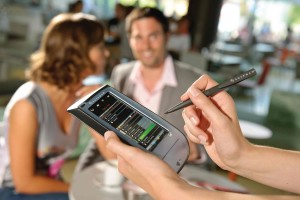Top 3 next generation EPoS technologies
Technology is rapidly changing the way we do business, to the point that it can be hard to keep up with the next hot property.
To keep you in the know, we’ve found three new contenders for the up and coming generation of technology:
Tablet jackets
Tablets have made an ultra smooth transition into home life and the business world blending seamlessly into the way we operate today. Entertainment, social media, web browsing, one-to-one presentations; and now continuing on its path to domination the tablet has transformed itself into an EPoS device simply by putting on a jacket.
The jacket or sleeve if you like, outfits the tablet with the kit to take payments in retail and hospitality environments. The equipment includes an imaging barcode scanner, a magnetic strip reader, a USB port and an optional second battery for added life should you wish to go mobile. A hand-strap, suitable for either a right-handed or left-handed user and a shoulder sling, are also available.
Key benefits:
- Mobile, on the spot payments
- Sleek attractive design, yet sturdy
Not so hot:
- May only fit certain tablets Could be a bit pricey
Tokenised card payments
Payments through mobile phones are tentatively on the rise. With ease of use clashing with fears of low security, consumers have been slow to embrace this method of EPoS, but there is a new app on the market to calm the nerves.
Tokenised card payments have been introduced to fill the gap between your bank account, the vendor and any potential fraudulent activity. The dynamic tokens replace your payment card information so that you don’t need to carry your wallet around everywhere, and risk it and your cards being stolen. It works much like the Oyster card and Pay Pal, but at the moment they’re not quite as straight forward, because they require you to purchase a plug-in magnetic strip reader.
Once you have the reader it’s all relatively simple and works in three steps: first you download the app and register your payment card, by swiping it on the reader. Next you create a code for that card, a cash limit and expiration date. The final step takes place when you make a payment; you open the app on your phone, enter the code to login in and show it to the vendor who then scans it and you’re done. No swipe or signatures needed.
Key benefits:
- Protects your sensitive card data
- Quick and easy way to pay
- Spending limit is controlled
Not so hot:
- You need to buy hardware to use the service
- Have to remember to top-up your cash limit
Hand held devices
Customer focused service is a key driver in the retail and hospitality sectors right now and hand held EPoS devices are a natural fit. The mobile nature of these devices enables employees to focus their attention around the customer and make transactions on the spot.
They work slightly differently for the two sectors and lend themselves particularly well to restaurants where employees can use the hand helds to take orders and send them directly to the kitchen and service staff without interruption. As a result service becomes faster by removing waiting time, and so guests get their food quickly.
Waiting staff are also finding that they are more aware of guests needs, because they are focussed on taking orders rather than chasing them. With faster and more efficient service guests are placing more orders, and increased sales means more turnover for the restaurant.
Key benefits:
- Mobile and customer focused
- Faster service
- Increased turnover
Not so hot:
- Expensive initial outlay
- Might need to restructure your service method
Look out for these technologies, they are set for big market opportunities.



No comments yet.